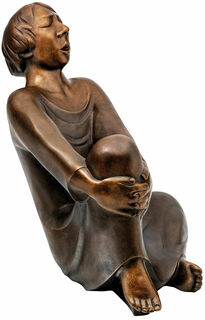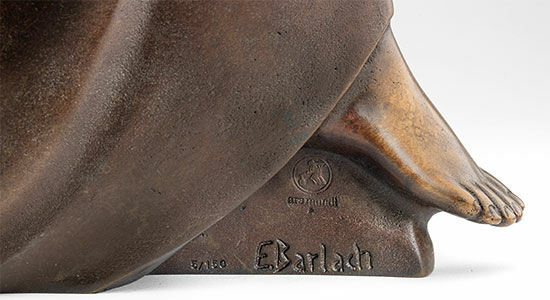Sculpture "Singing Man" (1928), bronze reduction, height 34 cm
Sculpture "Singing Man" (1928), bronze reduction, height 34 cm
Quick info
ars mundi exclusive edition | limited, 150 copies | numbered | signature | foundry hallmark | certificate | bronze | chased | patinated | reduction | size 34 x 26 x 40 cm (h/w/d) | weight approx. 13 kg
Detailed description
Sculpture "Singing Man" (1928), bronze reduction, height 34 cm
This masterpiece by Ernst Barlach, which was cast in bronze in 1928, is an icon of modernism and probably the most frequently represented sculptural work of German origin in the world. It adorns the covers of many illustrated books and is an integral part of world-famous museums and collections, including the Museum of Modern Art in New York.
This sculpture reveals the "infinity in the silent mirror of clear sounds, simple tones" (Barlach wrote in a note of 23 August 1914 about an unexpected musical experience). "Singing Man" exemplifies what Barlach defined as his artistic credo: "My mother tongue is the human figure, or the milieu, the object through which or in which the human being lives, suffers, rejoices, feels, thinks."
To celebrate the 150th anniversary of his birth, we have produced a limited edition of only 150 copies of his famous "Singing Man" as a large sculpture, exclusively available at ars mundi.
Fine bronze sculpture, hand-cast using the Lost-Wax-Process, chiselled and patinated. Moulded and reduced from the original. Limited edition of 150 copies worldwide, individually numbered and with the signature "E. Barlach" taken from the original as well as the foundry hallmark. ars mundi Exclusive Edition. With numbered certificate of authenticity and limitation. Size 34 x 26 x 40 cm (h/w/d). Weight approx. 13 kg.
"One of the most outstanding and popular designs in Ernst Barlach's oeuvre is 'Singing Man' from 1928. The artist was at the peak of his creative powers. Barlach's basic motif is the human being looking into his innermost being to the point of the abysmal. Posture, contemplation and thoughtfulness determine his expressions. Listening is part of singing. Breathing technique and speech must form a common arch from which purity emanates. Singing, like everything musical, is fleeting. What strikes the listener is not the song nor the content. It is the sequence of notes, the manner, the melos, the uniqueness in which the song inserts itself into the cosmos as a member of an infinite sequence. It is the profound moment of realisation that the artist captures in every single wrinkle of his robe, in his whole body. It resonates and resounds through the sculpture (Latin: personare) and makes the person of the singer the instrument of a more significant one." (Dr Friedhelm Häring - former museum director and curator)

About Ernst Barlach
1870-1938, sculptor, writer and draughtsman
Ernst Barlach was born on January 2, 1870, in Wedel, Germany, and died on October 24, 1938, in Rostock, Germany. He holds an outstandingly special position within German Expressionism. As a graphic artist, draughtsman, writer and, in particular, a sculptor, Barlach created milestones in art history. Barlach's sculptural works of art have a special effect because they seek extreme experience of limits and their representation. They are works of multi-layered meaning with which he foregrounded the essence of the human being and that what stands above the self and the world.
Barlach's intention is rooted in the depths, the inner self. Shaped by war and challenging living conditions, he experiences both suffering and happiness. The human being is always the focus of his work: Ecce homo.
"I desire nothing more than to be a good and true artist as best I can. I believe that what cannot be expressed through the work can pass into the possession of another through forms. My pleasure and creative impulse continually revolve around the problems of the meaning of life and the other great mountains in the spiritual realm." (Ernst Barlach)
Ernst Barlach became an honorary member of the Academy of Fine Arts, Munich, in 1925. In 1933, he was appointed Knight of the Peace Class of the Order "Pour le mérite". In 1937, the National Socialists removed his works from public collections and spaces for being "degenerate art". Ernst Barlach died in Rostock on October 24, 1938.
Today, Ernst Barlach's works are an integral part of leading museums and collections and - if available - fetch record amounts at auction.
"The Singing Man" became Ernst Barlach's best-known sculpture, an icon of Modernism. It adorns illustrated books and posters worldwide, and the original edition is a permanent part of the collections of the world's major museums, including the Museum of Modern Art (MoMA) in New York.
An alloy of copper with other metals (especially with tin) used since ancient times.
When casting bronze, the artist usually applies the lost-wax technique which is dating back more than 5000 years. It's the best, but also the most complex method of producing sculptures.
First, the artist forms a model of his sculpture. It is embedded in a liquid silicone rubber mass. Once the material has solidified, the model is cut out. The liquid wax is poured into the negative mould. After cooling down, the wax cast is removed from the mould, provided with sprues and dipped into ceramic mass. The ceramic mass is hardened in a kiln, whereby the wax flows out (lost mould).
Now we finally have the negative form, into which the 1400° C hot molten bronze is poured. After the bronze had cooled down, the ceramic shell is broken off and the sculpture is revealed.
Now the sprues are removed, the surfaces are polished, patinated and numbered by the artist himself or, to his specifications, by a specialist. Thus, each casting becomes an original work.
For lower-quality bronze castings, the sand casting method is often used which, however, does not achieve the results of a more complex lost-wax technique in terms of surface characteristics and quality.
Graphic or sculpture edition that was initiated by ars mundi and is available only at ars mundi or at distribution partners licensed by ars mundi.
Artistic movement that replaced Impressionism in the early 20th century.
Expressionism is the German form of the art revolution in painting, graphic art and sculpture, which found its precursor in the works of Paul Cézanne, Vincent van Gogh and Paul Gauguin in the late 19th century. The Expressionists attempted to advance to the primal elements of painting. With vibrant, unbroken colours in large areas and with the emphasis on the line and the resulting targeted suggestive expressiveness, they fought against the artistic taste established by the bourgeoisie.
The most important representatives of Expressionism were the founders of "Die Brücke" (The Bridge): Ernst Ludwig Kirchner, Erich Heckel, Karl Schmidt-Rottluff, Max Pechstein, Otto Mueller and Franz Marc, August Macke and others.
Masters of Viennese Expressionism are Egon Schiele and Oskar Kokoschka. Among the sculptors, Ernst Barlach is the most famous.
Fauvism is the French form of Expressionism.
Term for an art object (sculpture, installation), which is produced in multiple copies in a limited and numbered edition according to the artist‘s will.
Artist's multiples have been called the most accessible and affordable art on the market.
A plastic work of sculptural art made of wood, stone, ivory, bronze or other metals.
While sculptures from wood, ivory or stone are made directly from the block of material, in bronze casting a working model is prepared at first. Usually, it is made of clay or other easily mouldable materials.
The prime time of sculpture after the Greek and Roman antiquity was the Renaissance. Impressionism gave a new impulse to the sculptural arts. Contemporary artists such as Jorg Immendorf, Andora, and Markus Lupertz also enriched sculptures with outstanding works.












